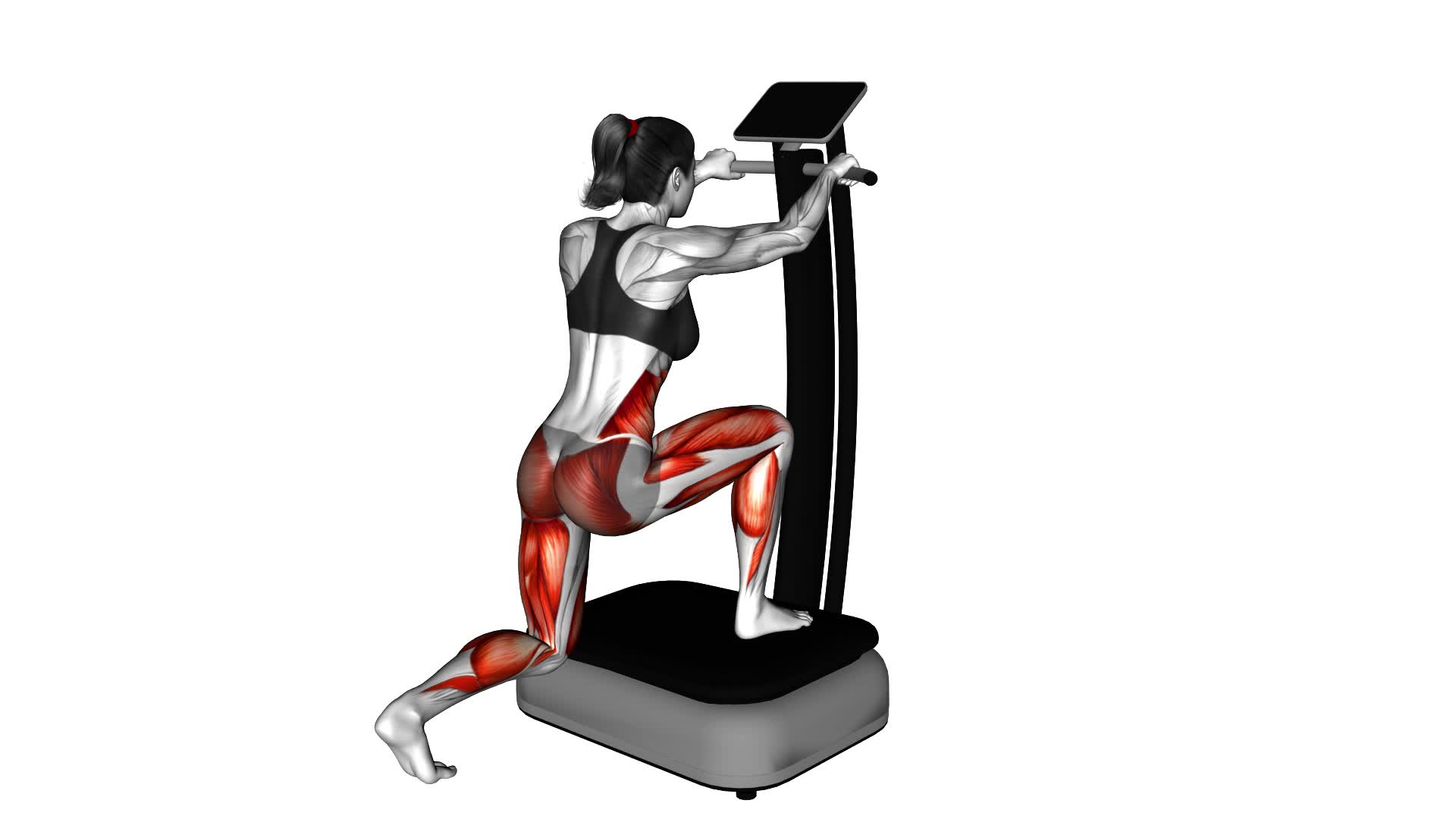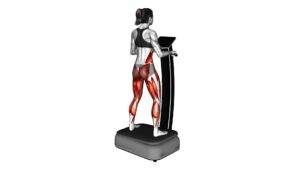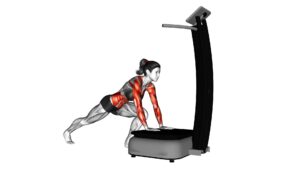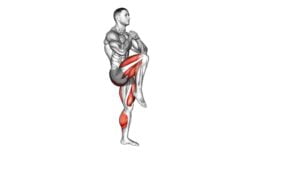Vibrate Plate Lunge (female) – Video Exercise Guide & Tips

Looking to amp up your leg workout? Check out the Vibrate Plate Lunge video exercise guide and get ready to feel the burn!
Watch This Exercise Video
This article provides you with expert tips and techniques to perfect your form and maximize your results. Whether you're a beginner or experienced, these variations and modifications will help you tailor the exercise to your fitness level.
Say goodbye to common mistakes and hello to stronger, sculpted legs.
Let's dive in and get those muscles shaking!
Key Takeaways
- Increased effectiveness of the exercise
- Targets multiple muscle groups simultaneously
- Improves balance and coordination
- Can be a safe and effective exercise when performed with proper form
Benefits of Vibrate Plate Lunges
Maximize your workout by incorporating vibrate plate lunges, which can help strengthen and tone your lower body. The benefits of vibrate plate lunges are numerous and can greatly enhance your fitness routine.
One of the main advantages is the increased effectiveness of the exercise. When performing lunges on a vibrating plate, your muscles are forced to work harder to maintain stability, which leads to greater muscle activation and engagement. This increased intensity results in more calories burned and a more efficient workout.
Another benefit of vibrate plate lunges is their ability to target multiple muscle groups simultaneously. By engaging your glutes, quadriceps, hamstrings, and calves, you can effectively tone and strengthen your entire lower body. Additionally, this exercise helps improve your balance and coordination, as you must stabilize yourself on the vibrating platform.
The effectiveness of vibrate plate lunges extends beyond just muscle strength and toning. They also help improve bone density and increase flexibility. The vibrations stimulate the bones, promoting bone growth and reducing the risk of osteoporosis. Furthermore, the dynamic nature of this exercise encourages mobility and flexibility in the hip and knee joints.
Proper Form and Technique
To perform vibrate plate lunges with proper form and technique, follow these guidelines:
- Maintain proper alignment: Stand with your feet hip-width apart and keep your spine straight throughout the exercise. Avoid leaning forward or backward, as this can strain your lower back.
- Engage your core: Before starting the lunge, engage your core muscles by pulling your belly button towards your spine. This will help stabilize your body and protect your lower back.
- Step forward with control: Take a controlled step forward with one leg, ensuring your knee is directly above your ankle and not extending past your toes. Keep your weight evenly distributed between your front and back legs.
- Push off with your front foot: As you return to the starting position, push off with your front foot and drive through your heel. This will engage your glutes and hamstrings, providing a more effective workout.
Common misconceptions about vibrate plate lunges include the belief that they're only beneficial for women. In reality, this exercise is suitable for both men and women and can help improve lower body strength and stability.
When performed with proper form, vibrate plate lunges can be a safe and effective exercise, but it's important to be mindful of common injuries such as knee strain. If you experience any pain or discomfort, it's recommended to consult with a fitness professional or healthcare provider.
Variations and Modifications
To add variety and challenge to your vibrate plate lunges, you can incorporate different variations and modifications. For advanced modifications, you can try adding weights to your lunges. Holding dumbbells or kettlebells in your hands while performing the exercise will increase the resistance and intensify the workout. This will help to strengthen and tone your leg muscles even more effectively.
Another option is to perform jumping lunges on the vibrate plate. Instead of stepping forward and backward, you'll jump and switch your legs in mid-air. This plyometric variation adds an element of cardiovascular fitness to the exercise, increasing your heart rate and burning more calories.
When it comes to equipment options, you can experiment with different types of vibrate plates. Some plates have adjustable settings that allow you to increase or decrease the intensity of the vibration. This can help you find the level that works best for your fitness level and goals.
Additionally, you may also consider using a stability ball during your lunges. Placing one foot on the ball while lunging with the other leg will challenge your balance and engage your core muscles even more.
Remember to always consult with a fitness professional or trainer before attempting advanced modifications or using different equipment to ensure proper form and technique.
How to Incorporate Vibrate Plate Lunges Into Your Workout Routine
To incorporate vibrate plate lunges into your workout routine, you can follow these steps:
- Start with the basics: If you're a beginner, it's important to understand the proper form and technique for vibrate plate lunges. Begin by standing on the vibrate plate with your feet hip-width apart. Step one foot forward into a lunge position, with your knee bent at a 90-degree angle. Push through your heel to return to the starting position and repeat on the other leg.
- Gradually increase intensity: As you become more comfortable with vibrate plate lunges, you can try incorporating more advanced variations. One option is to hold weights in your hands to add resistance and increase the challenge. Another option is to perform jump lunges on the vibrate plate, exploding up into the air and switching legs mid-air.
- Incorporate them into a circuit: To maximize the benefits of vibrate plate lunges, consider adding them to a circuit workout. Combine them with other exercises such as squats, push-ups, and planks for a full-body workout that targets multiple muscle groups.
- Listen to your body: It's important to listen to your body and adjust the intensity of your vibrate plate lunges accordingly. If you're a beginner, start with fewer repetitions and gradually increase as you get stronger. If you experience any pain or discomfort, stop immediately and consult with a fitness professional.
Common Mistakes to Avoid
Avoid these common mistakes when performing vibrate plate lunges to ensure proper form and maximize your results.
One of the most common mistakes isn't maintaining proper technique. It's important to focus on your form throughout the exercise to prevent injury and get the most out of your workout.
One mistake to avoid isn't keeping your chest and head up. It's common for people to lean forward during a lunge, but this can put unnecessary strain on your lower back and compromise your balance. Instead, keep your chest lifted and your head in a neutral position.
Another common mistake isn't engaging your core. Your core muscles play a crucial role in stabilizing your body during the lunge. To avoid this mistake, make sure to engage your core by pulling your belly button in towards your spine and maintaining a strong, stable core throughout the movement.
Lastly, be mindful of your knee alignment. It's important to ensure that your knee stays in line with your toes during the lunge. Avoid letting your knee collapse inward or push too far forward, as this can put stress on your knee joint.
Tips for Maximizing Results
Maximize your results by incorporating these tips into your vibrate plate lunge routine. By following these guidelines, you can ensure that you're getting the most out of your workout and reaping the benefits of vibrate plate lunges.
- Maintain proper form and technique: It's crucial to maintain proper form throughout the exercise to target the right muscles and prevent injury. Keep your back straight, shoulders relaxed, and core engaged. Ensure that your front knee stays aligned with your ankle and doesn't go past your toes. Also, make sure your back knee is hovering just above the ground.
- Engage your glutes and quads: To maximize the benefits of vibrate plate lunges, focus on engaging your glutes and quads during the exercise. This will help strengthen and tone these muscles effectively.
- Vary your lunge stance: Experiment with different lunge stances to target different muscle groups. Try forward lunges, reverse lunges, or side lunges. This variation will challenge your muscles in different ways and promote overall muscle development.
- Increase intensity gradually: As you become more comfortable with vibrate plate lunges, gradually increase the intensity by adding weights or changing the vibration settings on the plate. This progressive overload will help you continue to see results and avoid plateauing.
Frequently Asked Questions
What Are the Potential Risks or Drawbacks Associated With Doing Vibrate Plate Lunges?
Potential risks and drawbacks associated with doing vibrate plate lunges include the possibility of muscle strains or injuries if not performed with proper form or at a suitable intensity. It's important to take precautions and start with lighter weights or lower intensities, gradually increasing as your strength and stability improve.
Additionally, individuals with certain medical conditions, such as joint problems or balance issues, should consult with a healthcare professional before attempting this exercise.
Can Vibrate Plate Lunges Help With Weight Loss and Toning?
Using vibration plates for weight loss and toning can have many benefits.
One exercise you can try is the vibrate plate lunge.
To properly perform this exercise, start by standing on the vibration plate with one foot forward and the other foot back. Bend your knees and lower your body into a lunge position, making sure to keep your back straight.
This exercise can help strengthen and tone your leg muscles while also burning calories.
How Often Should Vibrate Plate Lunges Be Incorporated Into a Workout Routine for Maximum Effectiveness?
To achieve maximum effectiveness, it's important to incorporate vibrate plate lunges into your workout routine with the right frequency.
The frequency will depend on your fitness level and goals. Generally, it's recommended to perform vibrate plate lunges at least two to three times a week.
However, if you have knee or joint issues, it's crucial to modify the exercise to avoid further injury.
Consulting with a fitness professional can help you determine the appropriate frequency and modifications for your specific needs.
Are There Any Specific Recommendations for Individuals With Knee or Joint Issues When Performing Vibrate Plate Lunges?
When performing vibrate plate lunges, it's important to consider any knee or joint issues you may have. To protect your knees and joints, there are a few recommendations you can follow.
First, make sure to warm up properly before starting the exercise.
Additionally, you can modify the lunge by reducing the depth or using a stability aid for support.
If you have severe limitations, it may be best to consult with a healthcare professional for alternative exercises that prioritize knee and joint health.
Can Vibrate Plate Lunges Be Done by Beginners, or Is It Recommended for More Advanced Fitness Levels?
Vibrate plate lunges can be done by both beginners and more advanced fitness levels. They're a challenging exercise that can help improve leg strength and stability.
If you're a beginner, it's important to start with proper form and gradually increase the intensity. If you have knee or joint issues, modifications can be made to reduce impact, such as performing the lunges on a stable surface instead of the vibrating plate.
Always listen to your body and consult with a professional if needed.
Conclusion
Incorporating vibrate plate lunges into your workout routine can offer numerous benefits, including increased muscle strength, improved balance, and enhanced overall fitness.
By following proper form and technique, you can maximize the effectiveness of this exercise.
Additionally, variations and modifications allow for customization based on individual fitness levels and goals.
Avoiding common mistakes and implementing tips for maximizing results will ensure you get the most out of your vibrate plate lunge workouts.
Start incorporating this exercise today for a challenging and rewarding fitness routine.

Author
Years ago, the spark of my life’s passion ignited in my mind the moment I stepped into the local gym for the first time. The inaugural bead of perspiration, the initial endeavor, the very first surge of endorphins, and a sense of pride that washed over me post-workout marked the beginning of my deep-seated interest in strength sports, fitness, and sports nutrition. This very curiosity blossomed rapidly into a profound fascination, propelling me to earn a Master’s degree in Physical Education from the Academy of Physical Education in Krakow, followed by a Sports Manager diploma from the Jagiellonian University. My journey of growth led me to gain more specialized qualifications, such as being a certified personal trainer with a focus on sports dietetics, a lifeguard, and an instructor for wellness and corrective gymnastics. Theoretical knowledge paired seamlessly with practical experience, reinforcing my belief that the transformation of individuals under my guidance was also a reflection of my personal growth. This belief holds true even today. Each day, I strive to push the boundaries and explore new realms. These realms gently elevate me to greater heights. The unique combination of passion for my field and the continuous quest for growth fuels my drive to break new ground.







